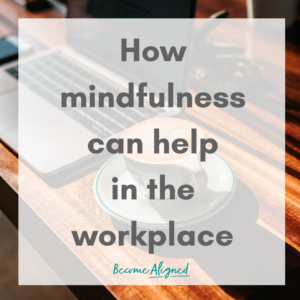How does mindfulness help in the workplace?
Mindfulness is becoming a well-known phrase.
But does it still conjure up images of people sitting on a circle of cushions at a retreat, chanting “ommm” for hours on end? How can we use mindfulness in our everyday lives, and how does mindfulness help in the workplace?
What is mindfulness?
Mindfulness is the modern term for something we used to do naturally. Before screens and technology filled up our every waking moment.
We used to have blank space in our days.
Space to listen to the sounds around us, to notice sights and smells as we were on a stroll, to focus fully on a craft or art project, or to simply be bored and stare into space, letting our minds wander. To just be.
We rarely have those blank spaces now, as our time gets filled up with constant, quick-firing information and communications.
So as much as mindfulness is nothing “new” – in the sense that we’ve always known how to do it – it is no longer something we have access to without putting in a bit of effort and creating space for.
Why do we need mindfulness?
Our bodies need a balance between how much time we spend in fight, flight or freeze mode (our sympathetic nervous system) versus the rest and recover mode (our parasympathetic nervous system).
Both are important states for us: sometimes we need some stress or fear to motivate us to take action; other times we need to feel calm and safe so that our bodies can focus on healing and resting.
Too much time spent in the fight, flight or freeze mode can impact our health, since our body is prioritising the immediate threat over our vital processes like sleep, digestion and rational thought.
Mindfulness helps us access our rest and recover mode. It give us relief from the constant state of stress that can result from busyness and demands on our time and energy.
Not only does it give us relief in the moment as we practice mindfulness, but a regular practice helps us find that rest and recover mode more easily and naturally with less effort.

Our work lives are increasingly busy and demanding. Even though there is much more awareness of the importance of mental health, we’re still inclined to prioritise our work over our health at times.
Meeting the next deadline can feel more important than pausing to think about how well we’ve eaten that day, when we last got some fresh air, or whether we’re actually breathing properly.
Mindfulness in the workplace
According to recent guidelines for workplaces issued by the National Institute for Health and Care Excellence (NICE), mindfulness is strongly recommended as something that employees should be offered or helped to access.
Regular mindfulness and meditation practices have been shown to actively develop the prefrontal cortex area of our brains, meaning that our ability to think rationally, cope with emotions and make clear decisions improves. In fact, a recent study even showed that different types of mindfulness and meditation can impact different aspects of our brain function.
In the workplace, we can be more efficient and make better decisions if we are using the front part of our brain. So training this part of our brain makes sense.
It might seem counterproductive, but it’s not!
How does mindfulness help in the workplace?
Taking time out of our day to spend a few mindful minutes can seem like a waste of time when we’re busy and feel like we have no time.
But it’s exactly the opposite.
Taking two minutes to pause, focus on the breath and re-centre ourselves, can be the difference between continuing to stare blankly at our screen and achieving nothing, or getting on with it and completing the task with a clear head.
How do I learn mindfulness?
There are many resources out there, such as the well-known Headspace app or the 5 Ways to Wellbeing, to help guide you on ways to build mindfulness into your daily life.
I also run beginner mindfulness courses, introducing a variety of methods and tips to practice, with the aim of providing a toolkit that you can take forward into your everyday life. We are all unique, and different techniques appeal to different people. The key is to find what you enjoy, and what calms you – you’re more likely to keep it up if you like it!
Get in touch if you’d like to find out more about my mindfulness courses.

